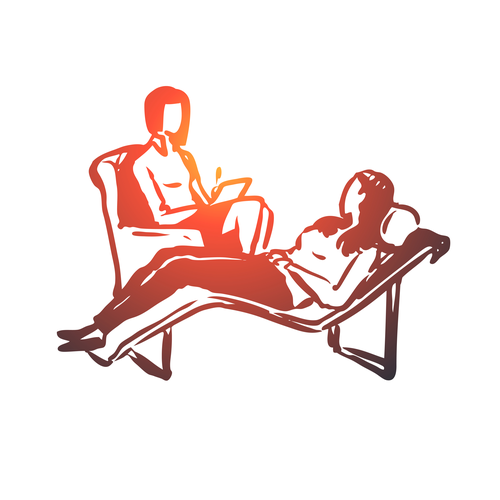
Posted November 2019 by John Sherk, B.S.W., B.S. Bible; MDiv.; 7 updates since. Reading time: 6 min. Reading level: Grade 10+. Questions on psychodynamic theory? Email Toni at: editor@online-psychology-degrees.org.
Everyone knows the traditional image of the client lying on the thick, leathered chaise longue with the therapist sitting close by with a notepad. This image originated with Sigmund Freud and his method of psychoanalysis. Psychodynamic therapy developed as a simplified, shorter version of psychoanalysis. While most of Freud’s later work and insights are considered outdated today, his overall approach remains relevant. It carries on psychodynamic therapy. Psychodynamic therapy techniques involve traditional talk therapy with focus on unconscious processes that impact behavior, particularly on the client’s relationship with his or her external world.
Psychodynamic Therapy Prolegomena
What does psychodynamic therapy assume about the human person? What does it presuppose as the human problem, and therefore, the solution to that problem? This will largely inform its stages, techniques, etc.
It’s important to note that psychodynamic therapy has a holistic approach to the person. This stands in contrast to other approaches like cognitive behavioral therapy, which seek to alleviate particular presenting problems in the client. While cognitive behavioral therapy may address the person as a whole, it always drives towards the end of tackling a particular issue. Psychodynamic therapy techniques and examples explore the client’s engrained needs, urges, and desires.
This is because psychodynamic therapy essentially shares the same anthropology which Freud developed. According to Freud, the mind divides into three competing and cooperating forces:
- Id – consisting of our instincts, and forms the basis for our unconscious mind
- Superego – our moral component that controls our beliefs of right and wrong,
- Ego – the mediator between the animal-like instincts of the id and the higher moral thought of the superego. It helps us to adhere to social mores and tries to reconcile the dialectical nature between the id and the superego.
Along with these forces at work in our minds, Freud divided the mind into 3 levels:
- The Unconscious: the level in which our instincts, most basic and fundamental beliefs, and many patterns of thought and behavior reside. Your perceptions of yourself, your world, your relationships with others, your deepest desires, etc. – they all reside here. Due to this level being unconscious, it takes a great deal of work to figure out what lies down in our unconscious. Freud believed the unconscious mind determines the majority of who we are, what we want, and how we act in order to get the things we want. The id rests here as well.
- The Subconscious: between the conscious and unconscious, this level can be accessed with some work. It includes much of the superego and ego.
- The Conscious: this is the level with which we are most familiar, yet gives us the least significant information about ourselves. According to Freud, your conscious will tell you that you acted a certain way towards a significant other because “You love them” or because “You just want to be close to them,” but the real reasons lie at the subconscious and unconscious levels; the reasons we provide at the conscious level are more socially acceptable than the real, often deviant or selfish reasons that lie underneath.
Psychoanalytic vs. Psychodynamic
Four major schools of thought developed out of psychoanalysis:
- Freudian
- Ego Psychology
- Object Relations
- Self-Psychology
Psychodynamic therapy techniques pull from each of these schools. Each of these schools holds nuanced theories of personality formation, psychopathology formation, change, and therapeutic techniques. Psychodynamic therapy finds overlap in these areas and applies them. It also tends to be exceptionally shorter and less intensive than its psychoanalytic father.
Stages of Psychodynamic Therapy
Historically, Freud’s approach has attempted to mirror the approach within the medical community regarding the doctor-to-patient relationship. Professional boundaries are strictly maintained, and the termination of the professional relationship is kept in mind throughout the process. While psychodynamic therapy techniques may not necessarily focus on one specific goal, problem, or need, the stages of psychodynamic therapy have a conclusion in mind. Freud’s approach to psychoanalysis has deeply influenced the stages of psychodynamic therapy, as well as the diagnostic school of social work. The stages of psychodynamic therapy can be summarized as:
- Commitment – establishing the therapeutic relationship, discussing motivation, and suitability.
- Process – involves examining patterns of thought and behavior, gathering information about the client’s motivations and defense mechanisms, and like processes.
- Change – grieving the loss of old patterns of thought and behavior, replacing them with new, healthier patterns of thought and behavior, and sustaining these new patterns.
- Termination –the stage where positive transference relations, regressive forms of dependence, and childish idealizations reach their final solution; the client reaches a state of autonomy, independent of the therapist.
Each stage can be broken down even further if necessary. For now, though, it’s important to note the broad flow of the stages. Additionally, notice that while past trauma and explicit problems might be addressed, the overall goal is much broader. The stages of psychodynamic therapy are reflected in its techniques and examples.
Psychodynamic Therapy Techniques and Examples
Psychodynamic therapy is a form of talk therapy or insight-oriented therapy. The key to change is to gain insight into the elemental forces of one’s thought and behavior and to change them. Seeing our emotions as revealing what truly lies underneath, therapists encourage their clients to talk about them in-depth. The therapist aids in connecting the dots between the emotions, the situation in which these emotions arose, and the childhood experiences which shaped how those situations bring about those emotions.
Additionally, to access the deeper parts of the self in the unconscious and subconscious, psychodynamic therapists might employ free association techniques, Rorschach inkblots, dream analysis, and paying attention to Freudian slips.
Let’s say you’re afraid of rollercoasters. Your conscious mind says you’re afraid of rollercoasters simply because they’re intense and you don’t like them. Through free association, we might learn that you fear roller coasters because you fear being controlled; a roller coaster will take you where it wants you to go, and there’s nothing you can do about it. How, then, might this fear impact your relationships, your work, your beliefs about the world, or even your voting habits? Psychodynamic therapy can bring all this out.
Psychodynamic Therapy for Anxiety
Can we use psychodynamic therapy for anxiety? How might it be effective to treat anxiety? The psychodynamic approach tends to avoid reducing any problem to something solely chemical. While medication will help someone with anxiety function normally, it won’t treat the underlying, often unconscious causes. If you seek this type of treatment, then you can expect to dive into distressing thoughts and feelings, and consider how your past can inform your present. This treatment will explore dreams, fears, and desires as a source of information about how you view yourself and others, how these impact your anxiety, and to help you make sense of your experiences with anxiety. Psychodynamic therapy for anxiety may also investigate defense mechanisms, how these relate to your fears, and how these relate to your anxieties.
Essential Psychodynamic Psychotherapy: An Acquired Art provides further insight into this therapy.
More Articles of Interest:
- New and Emerging Therapies: Mindfulness-Based Cognitive Therapy
- New and Emerging Therapies: Schema Therapy
- New and Emerging Psychology Therapies: EMDR
